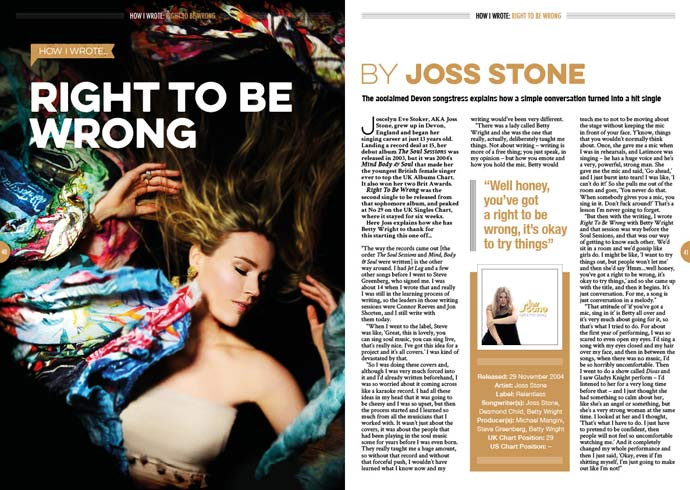Joss Stone, the soulful voice hailing from Devon, England, has captivated audiences worldwide since her teenage years. Her journey from a 13-year-old aspiring singer to a Grammy Award-winning artist is a testament to her raw talent and dedication. While her debut album, The Soul Sessions, introduced her to the world in 2003, it was her sophomore album, Mind Body & Soul, released in 2004, that solidified her place in music history. This album not only topped the UK charts, making her the youngest British female singer to achieve this feat, but also spawned the hit single, “Right To Be Wrong.” This track, the second single from Mind Body & Soul, became a fan favorite and charted for six weeks in the UK. In this article, Joss Stone herself unveils the story behind “Right To Be Wrong,” revealing the pivotal role of the legendary Betty Wright in its creation.
 Joss Stone 'Right To Be Wrong' single cover, as featured in Songwriting Magazine
Joss Stone 'Right To Be Wrong' single cover, as featured in Songwriting Magazine
Interestingly, the timeline of Joss Stone’s albums doesn’t reflect the order in which the songs were written. Prior to signing with Steve Greenberg, who eventually launched her career, Joss had already penned tracks like “Jet Lag” and others. At the young age of 14, she was actively developing her songwriting skills, collaborating with Connor Reeves and Jon Shorten, with whom she continues to write even today.
Upon joining the label, Steve Greenberg recognized Joss’s soulful voice and live performance ability. He envisioned a cover album project for her. Initially, Joss was disheartened by this direction. Having already written original material, she worried about the project sounding like karaoke and lacking originality. However, the experience of recording The Soul Sessions turned out to be transformative. Working alongside seasoned musicians from the soul music scene, individuals with decades of experience predating her birth, proved to be an invaluable learning opportunity. These collaborations went beyond simply recording covers; they became a masterclass in soul music. Joss acknowledges that this “forceful push” into The Soul Sessions was crucial in shaping her musical understanding and profoundly impacting her songwriting journey.
Among these influential figures, Betty Wright stood out as a deliberate mentor. While Joss believes songwriting is an intuitive and free-flowing expression, Betty focused on the nuances of performance and stage presence. She taught Joss the importance of microphone technique, emphasizing consistent mic placement even with dynamic stage movements. Betty’s lessons were practical and impactful. Joss recounts a rehearsal anecdote where Betty handed her a microphone while Latimore, a singer with a powerful voice, was performing. Overwhelmed, young Joss was brought to tears, feeling inadequate. Betty’s response was firm and unforgettable: “You never do that. When somebody gives you a mic, you sing in it. Don’t mess around!” This powerful lesson about seizing opportunities and overcoming fear resonated deeply with Joss.
The genesis of “Right To Be Wrong” can be traced back to a songwriting session with Betty Wright, predating The Soul Sessions. These sessions were informal and conversational, resembling typical girl-talk. Joss shared her desire to experiment and explore different musical avenues, but voiced concerns about potential resistance. Betty’s insightful response was the spark that ignited the song: “Well honey, you’ve got a right to be wrong, it’s okay to try things.” This simple yet profound statement became the song’s title and core message. For Joss, songwriting is fundamentally about conversation set to melody, capturing everyday dialogues and emotions in a musical form.
Betty Wright’s “if you’ve got a mic, sing in it” attitude permeated Joss’s approach to performance. However, in her early performances, Joss struggled with stage fright. For the first year, she would sing with her eyes closed, hiding behind her hair, feeling deeply uncomfortable between songs. A turning point came when she performed at a show called Divas and witnessed Gladys Knight on stage. Having admired Gladys Knight for years, Joss was struck by her calm and confident stage presence, describing her as “angelic” yet “strong.” Inspired by Gladys Knight’s demeanor, Joss realized she needed to project confidence, even if she felt internally anxious. This shift in mindset revolutionized her performances. She decided to “pretend to be confident,” a strategy that not only eased her own discomfort but also transformed the audience’s experience. This marked a significant evolution in Joss Stone’s stage presence, allowing her to connect with audiences more authentically and confidently.
Betty Wright’s influence extended far beyond just “Right To Be Wrong.” Her mentorship shaped Joss Stone’s approach to both songwriting and performance. From practical advice on microphone technique to the empowering message of embracing mistakes as part of growth, Betty Wright instilled invaluable lessons. “Right To Be Wrong” stands as a testament to their creative collaboration and the power of simple conversations to inspire soulful music. Explore more of Joss Stone’s captivating songs and discover the depth of her artistry at jossstone.com.
